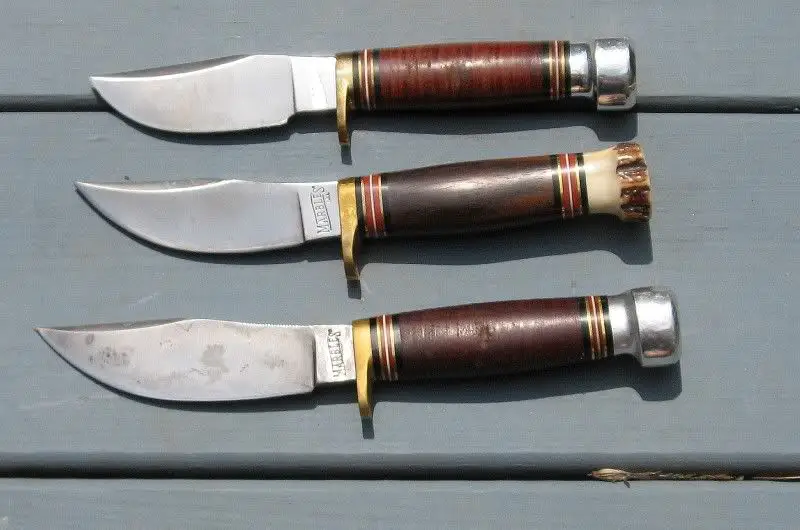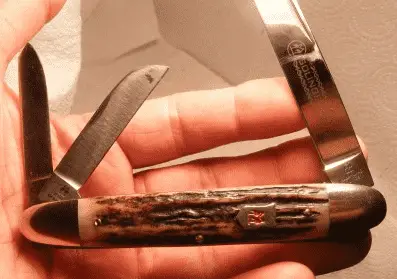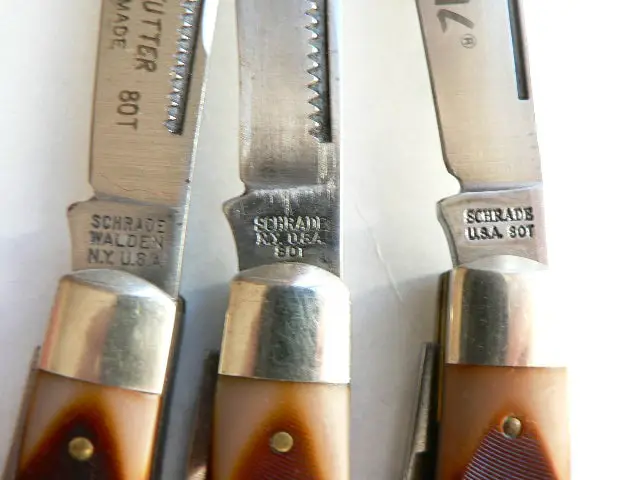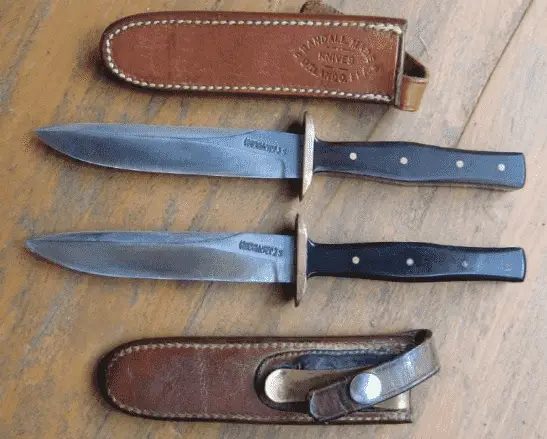Some of the best knives that we know today either came before any of the World Wars or were made because of one or both of those wars. True, those origins are shrouded in a lot of poor occurrences but the knives stayed on to mark those eras and the good work of manufacturers in that time.
One of those is the 1918 trench knife which I already discussed how to tell the original from the fake here. Today, we go into the Marbles knife to see how you can date them to a specific era.
Think yours came before or after WWII? Find out today.
History of the Marbles’ Knife

I know you didn’t come here for a history lesson, but these things help us when looking for what eras the knife might come from.
Take the dating guide for Schrade knives for example or the guide to dating Barlow knives as another. Since we know the years that the companies changed hands, it was easier to tell which era each knife came from.
That said, what is so special about the Marbles knives?
Around 1892, a visionary named Webster Marble set up the Gladstone Manufacturing Co. in Gladstone, Michigan. While Webster made a series of compasses, the universal rife sight, and other hunting tools, it was the Marble hunting knife series that caught the fancy of most patrons.
Perhaps one of the biggest testaments to how well-made this knife lies in Charles Lindbergh choosing the blade as his choice EDC for the transatlantic flight.
A man never chooses his EDC knives lightly, especially when going on tough expeditions. So, for the Marbles knife to have gone on this expedition, it must be truly special.
As if that is not enough, the Marbles hunting knives were ordered in droves by the British army around 1916, which was in the middle of the Great War. Years later, in 1958, the US Navy would also invest a lot in these knives to be issued to its soldiers.
One of the things that I love about the history of this company is that, unlike other knives that I’ve dated, they didn’t change hands too much. Even when they did, they didn’t make a fuss of it.
Till today, the company is in operation in its part of Michigan and they continue to make not just knives, but arms too.
Challenges with Dating the Marbles Knife

Fortunately, the company didn’t go through a lot of sales so we don’t have to worry about pinning what new design elements each new owner brought with them.
Still, there are a few challenges to dating these knives. The most obvious would be fake knife collectors and enthusiasts labeling a newer knife as an old unit so that they can get a lot of money for it.
Besides that, there were some design changes before and after WWI which we have to take into consideration. Blink too much and you might miss it.
Likewise, the subtle changes that Marble makes on the knives between certain eras make it such that we can easily miss the differences. Today, we need all our wits – as well as good eyes for detail – around us.
So, let’s get to it.
Popular Models from Marble
Marbles made quite the number of knives but they spread them out over unique models. Some of the popular ones that you are probably interested in dating today are:
- The Ideal model – first outdoor knife design created in 1898;
- The Expert model – created in 1906;
- The Woodcraft models
- The Fieldcraft

There are other models besides these but they are most likely too recent for you to care about dating it.
Marbles Vintage Knife Identification Guide
Follow the steps below for a better chance at dating your Marbles knife. While some of the methods work on their own, others are best taken into consideration with others to make a definite judgment.
#1 Look at the washer/ spacer patterns
One of the fastest ways to tell the era and sometimes, the exact year that a Marble knife is from, is by looking at the washer patterns.
This is not a feature on all Marble knives but helps to date the models made from 1997. According to the story, Mike Stewart (the VP of Marble at the time) thought that the knives should have a unique dating system, and he came up with this.
The washer patterns can be found as bands of different colors just at the point where the handle starts after the blade. You can find some different washer patterns, as well as the year they refer to, below:

For a more general guide into how these washer/ spacer patterns affect some other models too, use the legend below:
- the early 1920s: B-Br-R-Br-B
- the early 1930s: R-Br-B-Br-R-Br-B
- 1997: B-Br-R-R-Br-B-Br (pattern reverses on pommel end of handle).
- 1998: B-W-Br-R-R-Br-W-B
- 1999: B-Br-W-R-R-W-Br-B
- 2000: B-Br-Br-W-R-W-Br-Br-B
- 2001: B-W-Br-R-Br-W-B
- 2002: B-Br-R-W-R-Br-B
Where B = black; Br = brass; W= white; and R= red.
#2 The Pat’d tang stamp
Let me get this out of the way:
If your Marble’s fixed blade knife does not have the “Pat’d” marking, that does not make it a fake. It just means the knife might belong to another era, so you can check out other options on this list instead.
Marbles were making the model with their Pat’d tang stamp between 1916 and 1936. The company only lasted 20 years with this patented (where the stamp came from) stamp before other companies started to copy the design.
Since patents back then had a 20-year hold on them, that wasn’t surprising from the other brands.
You can further refine the dating period for the Pat’d model by the length of the handle. Here’s a guide to that:
- 3.75 inches – 1915-1928;
- 3 7/8 inches – 1928 – 1931; and
- 4 ¼ inches – later models.
#3 Position of the “A”
The letter A in MARBLES is also one of the fine ways to identify these knives.
Note, however, that this style only works for those knives made between 1911 and the early 50s.

The markings were in Serif fonts, and the letter A could either be seen facing right or left. Here’s how to date them apart:
- Serif A facing right – the 1940s to 1950s era;
- Serif A facing left – 1911 – 1930s era.
Check to see which yours is and date accordingly.
#4 Number of stamp lines
This occurred when dating Barlow knives too as the number of lines on some of the tang stamps helped cement the era that the knife was from.
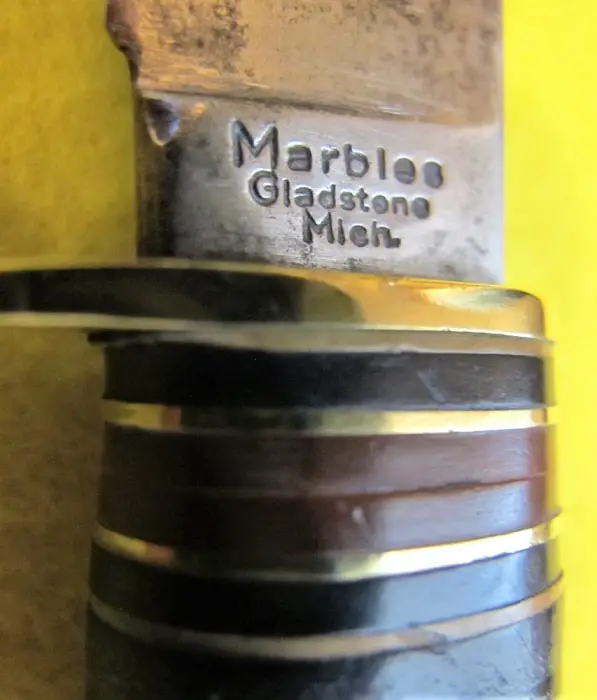
In this case, there are some interesting finds too:
- 3-line stamp, no USA stamp – usually featured on the Marbles Expert knife. Knives with this stamp date back to 1966-1974.
- 2-line stamps – way newer models. Featured on the trailblazer (as pictured above)
#5 Check with forums
This is one of my go-to tricks when every other thing fails. Sometimes, I choose forums even when I think I’m right, cos a second opinion never hurts.
Well, it could hurt if it was a wrong opinion, so only go with dedicated knife forums where you will find true enthusiasts. Even then, make sure you only trust the opinion of someone who knows what they are doing.
You can find a series of such dedicated knife forums online – from BladeForums to Smith & Wesson’s Knife Forums and AllAboutPocketKnives, among others.
Frequently Asked Questions
Are Marbles Knives made in the USA?
The initial range of Marbles knives was all made in the USA. Today, some of the manufacturing is outsourced to China to take advantage of the lower labor and production costs. All Marbles knives are still designed in the USA and only sent to China for production.
There are still some Marble knives made by the local company in Michigan, Ohio which you can find around today. These will come with the “MI, USA” stamp or other relevant stamps to show that they have been made within the States. However, it seems that the company stopped making anything out of the USA in 2008.
Did the Marble knife company ever go out of business?
Although they didn’t undergo any name change, the Marble knife company did change hands at some point.
The company first stopped making knives in 1976 – after which they came back to the market 20 years later. Mike Stewart was hired to spearhead the return to the market, during the era in which he brought the handle bands model for dating the knives to specific years.
The company has since had its trademark right sold in a move that saw the production moved overseas.
Are Marble knives good and worth any money?
The original Marble knives are so well-made that they are still around today, more than a hundred years after they were first made. It is even believed that some of the earlier models (from the late 1990s) had been made for long but stored in special oil drums because the stag material for their handles was scarce.
Those Woodcraft, Ideal, and Expert models that made it to the market continue to be of good use to those who have them today. Having seen both of the world wars and even been to the scene, it is little wonder why this knife can sell for low thousands of dollars today.
The newer models of these knives are believed to have lost the manufacturing quality that appealed to the initial set. This is believed to be a factor of the knife production being moved overseas – such as affected the Barlow knives too.
However, you can still find some good stock of the remaining Made in USA Marble knives from some knife shops today, and those don’t cost anywhere near the vintage models.

